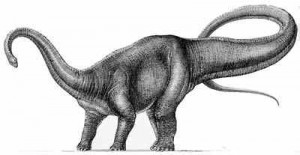Diplodocus Facts
Diplodocus is, without doubt, one of the most famous dinosaurs. It belonged to the group known as the sauropodomorphs and was around in the Late Jurassic period – specifically the Kimmeridgian and Tithonian eras roughly 154-150 million years ago. It reached sizes of up to 25 metres (82 feet) in length and was predominantly found in what is now North America. There were four species of diplodocus, with the largest of these being seismosaurus, which essentially translates to ‘ground shaker’.
Diplodocus was part of the diplodocid family, sharing the same characteristic of having 15 neck vertebrae, short forelimbs compared to the rest of its body and a whip-like tail. Its giant neck made up a large proportion of its body, but there is still some contention as to whether it held its neck vertically or horizontally.
Its rectangular skull contained huge eye sockets and nasal chambers, in addition to a long flat jawline and a small space for its comparatively little brain.
 Studies of its teeth suggest that diplodocus fed using what is known as branch stripping, where the branch of a tree is grasped in a creature’s Jaw and then pulled sharply up or down, tearing off foliage as it goes.
Studies of its teeth suggest that diplodocus fed using what is known as branch stripping, where the branch of a tree is grasped in a creature’s Jaw and then pulled sharply up or down, tearing off foliage as it goes.
For its time, diplodocus was the largest dinosaur around. It was later eclipsed by other sauropods, but it roamed the tallest for at least a few million years.
Numerous diplodocus bones have been found and studied by palaeontologists, providing an insight into how these giant dinosaurs were able to support themselves and generally how they lived.
Facts about Diplodocus
Head – Compared to the rest of its body, the diplodocus had a very small head.
Teeth – The teeth of diplodocus were peg-like, allowing it to strip foliage from branches.
 Stability – The outstretched tail counterbalanced the neck of the diplodocus, allowing the huge creature to remain stable.
Stability – The outstretched tail counterbalanced the neck of the diplodocus, allowing the huge creature to remain stable.
Spine – Running along its back, like other sauropods, were triangular spines on its vertebrae.
Tail – It’s highly likely that it was able to crack its whip-like tail at supersonic speeds, using it as a primary form of attack or defence.
Legs – Diplodocus could weigh up to 15 tons. It therefore needed huge, trunk-like legs to support its immense body weight.

